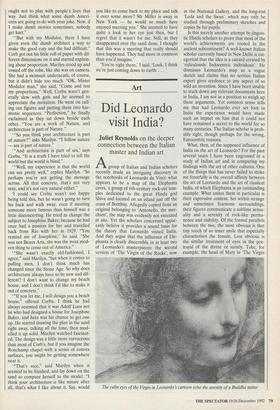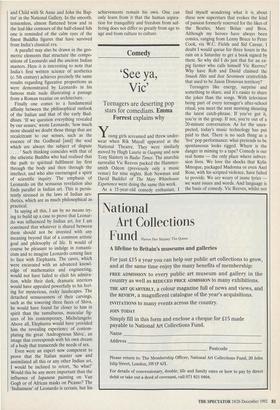Art
Did Leonardo visit India?
Juliet Reynolds on the deeper connection between the Italian master and Indian art Agroup of Italian and Indian scholars recently made an intriguing discovery in the notebooks of Leonardo da Vinci: what appears to be a map of the Elephanta caves, a group of 6th-century rock-cut tem- ples dedicated to the great Hindu god Shiva and located on an island just off the coast of Bombay. Allegedly copied from an original belonging to 'Antonello, the mer- chant', the map was evidently not executed in situ. Yet the scholars concerned appar- ently believe it provides a sound basis for the theory that Leonardo visited India. And they argue that the influence of Ele- phanta is clearly discernible in at least two of Leonardo's masterpieces: the second version of 'The Virgin of the Rocks', now in the National Gallery, and the long-lost 'Leda and the Swan', which may only be studied through preliminary sketches and copies by his pupils.
Is this merely another attempt by jingois- tic Hindu scholars to prove that most of the world's achievements are rooted in the ancient subcontinent? A well-known Italian scholar currently based in New Delhi is cat- egorical that the idea is a canard created by 'ridiculously Indocentric individuals'. He dismisses Leonardo's map as a vague sketch and claims that no serious Italian expert gives credence to any aspect of so wild an invention. Since I have been unable to track down any relevant documents here in India, I am not in a position to weigh up these arguments. Yet common sense tells me that had Leonardo ever set foot in India the experience would have made such an impact on him that it could not have remained a secret to the world for so many centuries. The Italian scholar is prob- ably right, though perhaps for the wrong, Eurocentric reasons.
What, then, of the supposed influence of India on the art of Leonardo? For the past several years I have been engrossed in a study of Indian art and in comparing my findings with the art of other cultures. One of the things that has never failed to strike me forcefully is the overall affinity between the art of Leonardo and the art of classical India, of which Elephanta is an outstanding example. What unites them in particular is their expressive content. Set within strange and sometimes fearsome surroundings, their figures communicate a sublime sensu- ality and a serenity of rock-like perma- nence and stability. Of the formal parallels between the two, the most obvious is that tiny touch of an inner smile that especially characterises the female. Less obvious is the similar treatment of eyes in the por- trayal of the divine or saintly. Take, for example, the head of Mary in 'The Virgin The calm eyes of the Virgin in Leonardo's cartoon echo the serenity of a Buddha statue and Child with St Anne and John the Bap- tist' in the National Gallery. In the smooth, tensionless, almost flattened brow and in the leaf-like contours of the half-closed lids one is reminded of the calm eyes of the finest Buddha figures that have survived from India's classical era.
A parallel may also be drawn in the geo- metric elements that structure the compo- sitions of Leonardo and the ancient Indian masters. Here it is interesting to note that India's first written science of aesthetics (c. 5th century) achieves precisely the same results regarding figurative proportions as were demonstrated by Leonardo in his famous male nude illustrating a passage from a Roman treatise on architecture.
Finally one comes to a fundamental affinity between the philosophical outlook of the Italian and that of the early Bud- dhists. 'If we question everything revealed by our senses,' wrote Leonardo, 'how much more should we doubt those things that are recalcitrant to our senses, such as the essence of the Godhead [and] the soul which are always the subject of dispute . . . . ' Such thinking coincides with that of the atheistic Buddha who had realised that the path to spiritual fulfilment lay first through the body and then through the intellect, and who also encouraged a spirit of scientific inquiry. The emphasis of Leonardo on the sensuous revelation also finds parallel in Indian art. This is persis- tently stressed in the laws of Indian aes- thetics, which are as much philosophical as practical. In saying all this, I am by no means try- ing to build up a case to prove that Leonar- do was influenced by Indian art, for I am convinced that whatever is shared between them should not be invested with any meaning beyond that of a common artistic goal and philosophy of life. It would of course be pleasant to indulge in romanti- cism and to imagine Leonardo coming face to face with Elephanta. The caves, which were excavated with an advanced knowl- edge of mathematics and engineering, would not have failed to elicit his admira- tion, while their dark, dramatic interiors would have appealed powerfully to his feel- ing for mysterious, rocky landscapes. The detached sensuousness of their carvings, such as the towering three faces of Shiva, he would have found far closer to him in spirit than the tumultuous, muscular fig- ures of his contemporary, Michelangelo. Above all, Elephanta would have provided him the revealing experience of contem- plating the great 'Androgynous Shiva', an image that corresponds with his own dream of a body that transcends the needs of sex.
Even were an expert now competent to prove that the Italian master saw and assimilated all this or any other Indian art, I would be inclined to retort, 'So what!' Would this be any more important than the influence of Japanese painting on Van Gogh or of African masks on Picasso? The `Indianness' of Leonardo is certain, but his achievements remain his own. One can only learn from it that the human aspira- tion for tranquillity and freedom from suf- fering does not differ so greatly from age to age and from culture to culture.











































































































 Previous page
Previous page